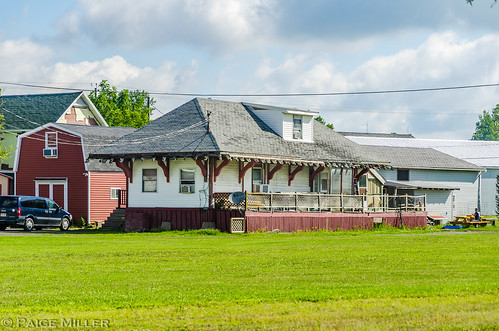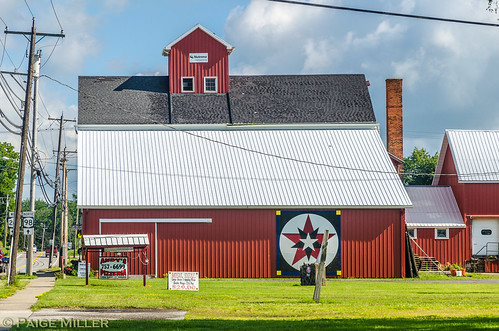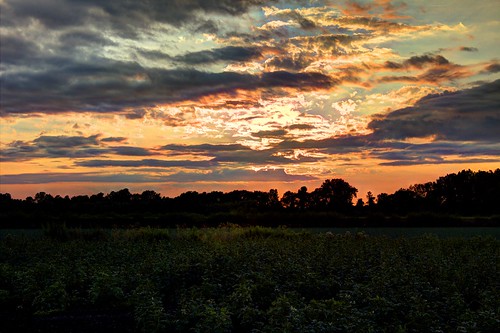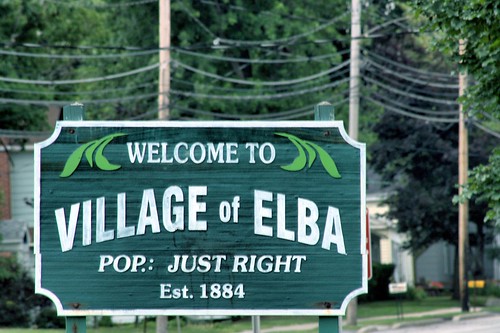The swamps, from which the Elba mucklands were created, were the Tonawanda and Oak Orchard Marsh. When investors moved in, starting in 1910, past plans were being seriously considered to drain the swamp. The earliest plans to drain the swamp though began in 1902. Mr. Landers of Alabama, NY and Mr. Peter Belson of Oakfield, NY early promoters of the draining. Hearings were held so all towns affected by the draining could have a voice in the process. Most of which were all for it, citing the localized water damage and illnesses caused by the swamps.
Representatives involved in the hearings were the towns affected by the future drainage. These towns were the towns of Barre, Clarendon, Alabama, Shelby, Oakfield, and Elba. Elba's hearing was held on May 13, 1902 and was one that garnered the most interest. The arguments made for draining the swamps were like those made in other towns. The majority view that the swamps caused disease and flood damage. Spectators were in support of the idea too. So as long as the project wouldn't be too costly. It is after these hearings, in August of 1903, that the plans were created to drain the swamp. In the Commission's findings it was declared that a main drainage channel would be started in the eastern area of the swamp and continued in westerly direction and following a path to connect to the Oak Orchard Creek. The plans included widening and deepening the Oak Orchard Creek. Later surveying of the land was used to plan where the lateral channel would be dug. These lateral channels which are still clearly visible in Elba. Specifically within numerous areas of the woods between the eastern segment of Ridge Road and West Muck Road to the North.
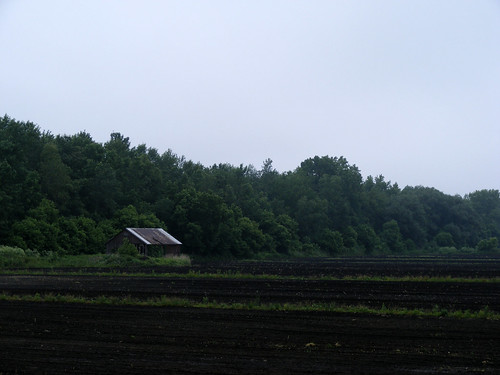
In April and May of 1904, the plans were further declared and the Commission said that all 25,760 acres to be drained could be reclaimed. It was on May, the 4th, that $5,000 would cover the costs of surveying and other initial work prior to drainage. In 1906, the surveyors began working on the early planning stages to drain the swamp. In the spring of 1909, the swamp experienced large scale flooding and looked like a lake at the time. Many roads were flooded under by the rise in water.
The opposite was happening by the fall. A drought over the summer had created conditions that were financially harming farms. Many farmers' properties, including hay and straw crops, were burned in an uncontrolled wildfire. Part of the swamp also ignited after drying out.
In 1910, Professor Carr, from Washington DC, came in to analyze the soil for its viability and quality. By 1911, local newspapers were reporting on the developments. An article in the Daily News, on February 27, 1911, reported that the Big Swamp was soon to be drained. After this, a lot of planning, land dealings, and business dealings occurred. Also, interest in the future mucklands increased. Deals which included companies who'd clear out timber from the drained swamp areas.
Of the acres reclaimed in the draining, 5,721 went to the Town of Alabama, 4,044 to Oakfield, 3,511 to Elba, 524 to Byron, 3,482 to Shelby, 6,117 to Barre, and 2,361 to Clarendon. The contract bidding for the drainage began in January of 1913. The contract was awarded to R.H. and G.A. McWilliams of Chicago. The contract was worth $110,000 and work was to start within 60 days.
Preparations began in April after the arrival of equipment via the West Shore Railroad. The railroad, which existed a short distance past ECS up until the latter 1980s. The dredge, once assembled, would only travel about a 1/2 mile a day. While its destination, at Transit Road, was roughly 6 miles away. The dredge, being so large, telephone wires had to be temporarily removed by telephone linemen. This was done as the machine passed through the Village of Elba. At one point, the dredge broke down at South Main Street. It needed replacement parts, from Evansville, Indiana, that took a week to arrive. After being repaired, the dredge took ten days to reach its Transit Road destination.
Work began on June 6, 1913. The dredges (Bucyrus dredges, i believe) were put into position at Transit Road, at the Oak Orchard Creek. The wooden dredge scow, constructed on the Oak Orchard Creek, that followed the dredges was 20 feet wide and 82 feet long. As the work commenced and the machine moved along many came to Elba to view the machine at work. So many visitors came to see the dredging operations that traffic, on Sundays, was non-stop. At this time, purchasing of land and properties increased in Elba in preparation for the new farmland. By August of 1913, the dredge work was going well and they were progressing by around 600 feet per day. New business kept coming into Elba throughout the rest of 1913 and throughout 1914. Which also brought new families into the area.
By the late summer of 1914, many new farms were in operation and growing crops on the rich mucklands. Others had planted orchards on their new acreage. After a little more than two years of dredging, in December of 1915, the drainage work was done. Dredging equipment returned to its 'home', being taken back along the West Shore Railroad. The efforts of the draining of the swamp contributed greatly to Elba's growth in those earlier days. Those efforts still contribute to the success of Elba's farms still in operation today.
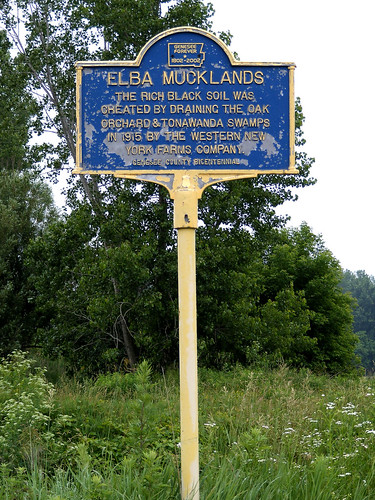
The downside is that, with every passing season, the Elba mucklands reduce in viability. Fires have occurred on the mucklands during times of drought going back to the 1930s. The Soil Conservation Service, since 1954, has done annual checks on the soil to measure how much has been lost, year-by-year.
Only time will tell how long the Elba mucklands will last before extensive muckland restoration is needed.
Representatives involved in the hearings were the towns affected by the future drainage. These towns were the towns of Barre, Clarendon, Alabama, Shelby, Oakfield, and Elba. Elba's hearing was held on May 13, 1902 and was one that garnered the most interest. The arguments made for draining the swamps were like those made in other towns. The majority view that the swamps caused disease and flood damage. Spectators were in support of the idea too. So as long as the project wouldn't be too costly. It is after these hearings, in August of 1903, that the plans were created to drain the swamp. In the Commission's findings it was declared that a main drainage channel would be started in the eastern area of the swamp and continued in westerly direction and following a path to connect to the Oak Orchard Creek. The plans included widening and deepening the Oak Orchard Creek. Later surveying of the land was used to plan where the lateral channel would be dug. These lateral channels which are still clearly visible in Elba. Specifically within numerous areas of the woods between the eastern segment of Ridge Road and West Muck Road to the North.

In April and May of 1904, the plans were further declared and the Commission said that all 25,760 acres to be drained could be reclaimed. It was on May, the 4th, that $5,000 would cover the costs of surveying and other initial work prior to drainage. In 1906, the surveyors began working on the early planning stages to drain the swamp. In the spring of 1909, the swamp experienced large scale flooding and looked like a lake at the time. Many roads were flooded under by the rise in water.
The opposite was happening by the fall. A drought over the summer had created conditions that were financially harming farms. Many farmers' properties, including hay and straw crops, were burned in an uncontrolled wildfire. Part of the swamp also ignited after drying out.
In 1910, Professor Carr, from Washington DC, came in to analyze the soil for its viability and quality. By 1911, local newspapers were reporting on the developments. An article in the Daily News, on February 27, 1911, reported that the Big Swamp was soon to be drained. After this, a lot of planning, land dealings, and business dealings occurred. Also, interest in the future mucklands increased. Deals which included companies who'd clear out timber from the drained swamp areas.
Of the acres reclaimed in the draining, 5,721 went to the Town of Alabama, 4,044 to Oakfield, 3,511 to Elba, 524 to Byron, 3,482 to Shelby, 6,117 to Barre, and 2,361 to Clarendon. The contract bidding for the drainage began in January of 1913. The contract was awarded to R.H. and G.A. McWilliams of Chicago. The contract was worth $110,000 and work was to start within 60 days.
Preparations began in April after the arrival of equipment via the West Shore Railroad. The railroad, which existed a short distance past ECS up until the latter 1980s. The dredge, once assembled, would only travel about a 1/2 mile a day. While its destination, at Transit Road, was roughly 6 miles away. The dredge, being so large, telephone wires had to be temporarily removed by telephone linemen. This was done as the machine passed through the Village of Elba. At one point, the dredge broke down at South Main Street. It needed replacement parts, from Evansville, Indiana, that took a week to arrive. After being repaired, the dredge took ten days to reach its Transit Road destination.
Work began on June 6, 1913. The dredges (Bucyrus dredges, i believe) were put into position at Transit Road, at the Oak Orchard Creek. The wooden dredge scow, constructed on the Oak Orchard Creek, that followed the dredges was 20 feet wide and 82 feet long. As the work commenced and the machine moved along many came to Elba to view the machine at work. So many visitors came to see the dredging operations that traffic, on Sundays, was non-stop. At this time, purchasing of land and properties increased in Elba in preparation for the new farmland. By August of 1913, the dredge work was going well and they were progressing by around 600 feet per day. New business kept coming into Elba throughout the rest of 1913 and throughout 1914. Which also brought new families into the area.
By the late summer of 1914, many new farms were in operation and growing crops on the rich mucklands. Others had planted orchards on their new acreage. After a little more than two years of dredging, in December of 1915, the drainage work was done. Dredging equipment returned to its 'home', being taken back along the West Shore Railroad. The efforts of the draining of the swamp contributed greatly to Elba's growth in those earlier days. Those efforts still contribute to the success of Elba's farms still in operation today.

The downside is that, with every passing season, the Elba mucklands reduce in viability. Fires have occurred on the mucklands during times of drought going back to the 1930s. The Soil Conservation Service, since 1954, has done annual checks on the soil to measure how much has been lost, year-by-year.
Only time will tell how long the Elba mucklands will last before extensive muckland restoration is needed.




